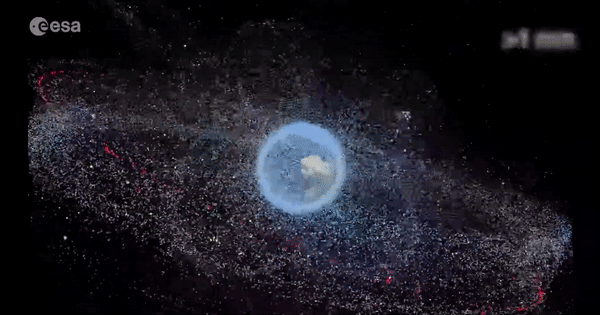The growing space junk problem
A familiar sight
You might have seen them when looking up at the night sky: straight lines of stars, artificially moving through the celestial sky. And no, sadly, it's not the universe lining up the stars for you tonight. It's a 'train' of just-released satellites, as you've probably already figured. This phenomenon has quickly become a common sight for those regularly observing the night sky - looking both impressive, beautiful, and a bit unsettling at the same time.

Another crowded night
Such sightings are merely a symptom of something bigger: the number of satellites in orbit is skyrocketing. Satellites support countless services embedded in our daily lives, from GPS and weather forecasts to environmental monitoring, broadband internet, and telecommunications.
There are currently more than 14,000 satellites in orbit and an even greater amount of fragmented pieces of debris - resulting from previous collisions and (un)intentionally destroyed satellites. ESA estimates the number of objects larger than 10cm in Earth orbit to be 54,000, and 1.2 million objects between 1 and 10cm.

Routine collision avoidance
For operators of LEO (Low-Earth Orbit) satellites, orbiting between roughly 300 and 2,000 km above Earth (the most crowded region of space) collision avoidance maneuvers are becoming more and more of a routine operation. Such maneuvers slightly change the orbital path of a satellite, so that two satellites at risk of colliding with each other can avoid doing so. Even the ISS (International Space Station) now regularly performs such maneuvers to avoid debris and protect the astronauts onboard.
Even space has limited space
It’s easy to think of space as infinite, empty, and boundless. But the regions around Earth used for satellites are anything but limitless. In fact, there's a slumbering issue waiting for us that is described by the Kessler Syndrome.
The Kessler Syndrome tells us that there's a limited number of objects that can safely orbit our Earth. The denser the cloud of objects in orbit, the higher the risk of collisions. If it becomes too crowded, a single collision could trigger a chain reaction, producing more debris and setting off further impacts.
Not only will this reaction destroy existing satellites, this domino effect could make parts of space unusable for decades or even centuries. And if we continue at the current pace of satellite launches, such a chain reaction could occur within our lifetime.
Ensuring safe space operations
So we're facing a well-understood and very dangerous problem, but how do we move forward? Before we dive into potential solutions, it's useful to underline why the problem has arisen.
Unfortunately, the core problem is straightforward: global regulations have lagged behind the pace of satellite launches. In practice, this means that operators were not forced to clean (read: remove from orbit) their spacecraft after its operational phase (usually 5-15 years). When not actively removed from orbit, satellites (and other hardware such as launcher stages) can continue orbiting the Earth for hundreds of years, becoming uncontrolled pieces of debris moving at ~7.5-8.0 km/s through space. It must be noted that the European and American guidelines were, up until quite recently, to clean up your satellite within 25 years after ending operations; however those were not actively enforced.
Fortunately, that’s changing as the awareness around space sustainability is growing. Both Europe and the US now require satellites to be deorbited within 5 years after their operational life ends. This shift has already led to the first-ever fine issued to a US company for failing to comply, indicating that a stronger push for enforcement is finally underway.
Addressing the problem
Traditionally, satellites are deorbited using onboard propellant to slow them down so that they can burn up in the atmosphere. But this requires the spacecraft to stay operational during the descent until burn up. So that solution comes with trade-offs: carrying extra fuel limits payload, increases costs due to increased operational time, and it sets higher constraints on your system's hardware, as it will need to be validated to survive and remain functional for a longer period of time. In addition to this, the reliability of propulsion systems remains an issue, especially for CubeSats.
This is where Gama comes in. At Gama, we're developing Astrobrake, our answer to the space debris problem. Astrobrake is an aerobraking device in the form of a drag sail: a deployable structure with a large surface area, meant to clean up a satellite after its operational phase has ended. Instead of the natural decay of hundreds of years, we bring it down in a maximum of 5 years, compliant with the new regulations.
If you want to read more about Astrobrake, please watch out for our next blog fully dedicated to it. We believe Astrobrake is a crucial step toward protecting the space environment and ensuring safe, reliable space services for future generations.
Join us on this journey - follow our blog, visit our website, and connect with us on LinkedIn for regular updates. The future of space is here, and we’re just getting started.


